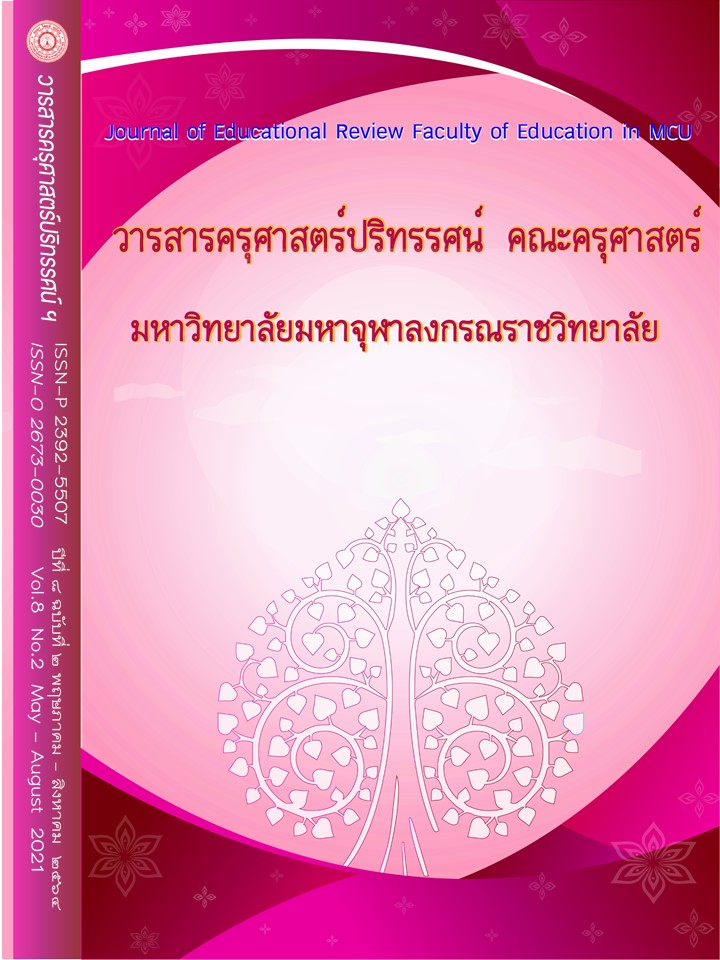INFORMATION SYSTEM DEVELOPMENT OF NAKHON NAYOK’S OTOP TOURIST
Main Article Content
Abstract
This research paper aims to study the design and development of information systems for developing the potential of the OTOP tourism community in Nawatwithi, Nakhon Nayok Province. User satisfaction assessment of the website a study comparing the satisfaction of the website and suggestions for website development by collecting information from the documents of the Planning Division Department of Community Development, Nakhon Nayok Provincial Community Development Office Study the main content of the website. Website design And a questionnaire was used with a sample of 500 people, including Community leaders, business, government, academia and Thai tourists in Nakhon Nayok tourist destinations are Ban Nern Saad and Ban Thung Skirt Ban Nong Hua Ling Nai Ban House Ban Huamon Klong 15 and Ban Kut Rang The data were analyzed by percentage, mean, standard deviation, t-test and F-test (One-way ANOVA) The findings indicated that. 1) Main content of the website And the organization of the system to obtain the tourism information structure OTOP Nawatwithi Nakhon Nayok Province consists of 1.1 information on tourist attractions, OTOP products, highlights of the community. Travel routes, check-in points, educational resources of each community Nakhon Nayok Province Homestay, local food, art, culture, traditions, OTOP products, activity pictures and contact channels for details About the OTOP Nawatwithi Tourism Community, Nakhon Nayok Province 1.2 website design, including (1) design of the home page (Homepage), the homepage of the website Linked from the home page of the OTOP Nawatwithi Tourism Community Village in Nakhon Nayok Province. 2) Satisfaction on the website Overall is at a high level. 3) The website's satisfaction comparison was classified by gender, age, education level. And the frequency of accessing the website has no different opinions. When comparing each side, there is no difference. 4) Suggestions are (1) adding information on tourist attractions, restaurants, hotels, accommodation, and travel to be updated (2) Creating interaction with tourists. (Interactive) via online chat (Live Chat) (3) Change all web pages to a second language.
Article Details
ทัศนะและความคิดเห็นที่ปรากฏในบทความในวารสารฉบับนี้ถือเป็นความรับผิดชอบของผู้เขียนบทความนั้นเพียงผู้เดียว และไม่ถือเป็นทัศนะและความรับผิดชอบของกองบรรณาธิการ
กองบรรณาธิการขอสงวนสิทธิ์ในการคัดเลือกบทความลงตีพิมพ์และจะแจ้งให้เจ้าของบทความทราบหลังจากผู้ประเมินบทความตรวจอ่านบทความแล้ว
ต้นฉบับที่ได้รับการตีพิมพ์ในวารสารครุศาสตร์ปริทรรศน์ คณะครุศาสตร์ มหาวิทยาลัยมหาจุฬาลงกรณราชวิทยาลัย ถือเป็นกรรมสิทธิ์ของคณะครุศาสตร์ มหาวิทยาลัยมหาจุฬาลงกรณราชวิทยาลัย ห้ามนำข้อความทั้งหมดหรือบางส่วนไปพิมพ์ซ้ำ เว้นเสียแต่ว่าจะได้รับอนุญาตจากมหาวิทยาลัยฯ เป็นลายลักษณ์อักษร
References
สำนักงานคระกรรมการข้อมูลข่าวสารของราชการ. (2559). การแบ่งประเภทผลิตภัณฑ์โอทอป แนวทางและหลักเกณฑ์การคัดสรรสุดยอดหนึ่งตำบล หนึ่งผลิตภัณฑ์ไทย ปี พ.ศ. 2559 (OTOP Product Champion: OPC). แหล่งที่มา http://www.oic.go.th/FILEWEB/CABINFOCENTER11/DRAWER022/GENERAL/DATA0000/00000012.PDF สืบค้นเมื่อ 5 พ.ย. 2562.
กรมการพัฒนาชุมชน กระทรวงมหาดไทย. (2561). คู่มือบริหารโครงการชุมชนท่องเที่ยว OTOP นวัตวิถี. กรุงเทพมหานคร: กรมการพัฒนาชุมชน.
คัมภีรพรรณ จันทร์แก้ว. (2562). บทบาทเทคโนโลยีสารสนเทศในชีวิตปัจจุบัน. แหล่งที่มา https://www.gotoknow.org/posts/425567 สืบค้นเมื่อ 10 มี.ค. 2562.
เจนจิรา หวังหลี และคณะ. (2563). การพัฒนาเว็บไซต์ส่งเสริมการท่องเที่ยวเชิงนิเวศ จังหวัดตรัง. รายงานการวิจัย. มหาวิทยาลัยราชภัฎสวนดุสิต.
บุญชม ศรีสะอาด. (2545). การวิจัยเบื้องต้น. พิมพ์ครั้งที่ 7. กรุงเทพมหานคร: สุวีริยาสาส์น.
บุญชม ศรีสะอาด. (2553). การวิจัยเบื้องต้น. พิมพ์ครั้งที่ 8. กรุงเทพมหานคร: สุวีริยสาสน์.
ปรมะ สตะเวทิน. (2546). หลักนิเทศศาสตร์. กรุงเทพมหานคร: รุ่งเรืองสาส์น.
พวงรัตน์ ทวีรัตน์. (2540). วิธีการวิจัยทางพฤติกรรมศาสตร์และสังคมศาสตร์. พิมพ์ครั้งที่ 7. กรุงเทพมหานคร: สำนักทดสอบทางการศึกษาและจิตวิทยา มหาวิทยาลัยศรีนครินทร์วิโรฒ.
เพ็ญนภา จุมพลพงษ์, พันธ์ศักดิ์ พึ่งงาม และสุธิษา เชญชาญ. (2560). การพัฒนาเว็บไซต์เพื่อส่งเสริมการท่องเที่ยวอย่างยั่งยืนของจังหวัดลพบุรี. รายงานวิจัย. มหาวิทยาลัยราชภัฏเทพสตรี.
ภานุพงศ์ ลือฤทธิ์. (2560). คุณภาพการบริการอิเล็กทรอนิกส์ในการสร้างความพึงพอใจของผู้ใช้งาน: กรณีตัวอย่างของแอปพลิเคชันกระเป๋าเงินบนโทรศัพท์มือถือ. การค้นคว้าอิสระหลักสูตรวิทยาศาสตรมหาบัณฑิต. มหาวิทยาลัยธรรมศาสตร์.
รุจเรศ แสงข่อง และสุทธาวรรณ จีระพันธุ์. (2558). พฤติกรรมและความพึงพอใจของผู้ใช้บริการอินเตอร์เน็ตในร้าน HAPPY SHOP. รายงานวิจัย. มหาวิทยาลัยหอการค้าไทย.
ศูนย์วิจัยนวัตกรรมอินเทอร์เน็ตไทย. (2553). การออกแบบหน้าเว็บเพจ. แหล่งที่มา https://truehits.net/ สืบค้นเมื่อ 10 มี.ค. 2563.
อัครเดช ปิ่นสุข. (2558). การยอมรับเทคโนโลยีสารสนเทศ คุณภาพการบริการอิเล็กทรอนิกส์และส่วนประสมการตลาดในมุมมองของลูกค้าที่ส่งผลต่อความพึงพอใจ (E-satisfaction) ในการจองตั๋วภาพยนตร์ออนไลน์ผ่านระบบแอพพลิเคชั่นของผู้ใช้บริการในจังหวัดกรุงเทพมหานคร. วิทยานิพนธ์บริหารธุรกิจมหาบัณฑิต. มหาวิทยาลัยกรุงเทพ.
Aconnect.co.th. (2563). Live Chat ช่วยแก้ไขปัญหาการสอบถามของลูกค้าได้. แหล่งที่มา https://www.aconnect.co.th/news_c/th/47 สืบค้นเมื่อ 20 ม.ค. 2563.
Amin, M., Rezaei, S., & Abolghasemi, M. (2014). User satisfaction with mobile websites: the impact of perceived usefulness (PU), perceived ease of use (PEOU) and trust. Nankai Business Review International. 5(3). 258-274.
Blog.ourgreenfish.com. (2562). พฤติกรรมการใช้ Internet ของคนไทยในปี 2562 เติบโตขึ้นอย่างไร?. แหล่งที่มา https://blog.ourgreenfish.com/thailand-internet-user-behavior-2019-grow สืบค้นเมื่อ 10 ม.ค. 2562.
C-tech.ac.th. (2562). เทคโนโลยีสารสนเทศ. แหล่งที่มา http://c-tech.ac.th/new/infor_tech.php สืบค้นเมื่อ 10 ม.ค. 2562.
Cronbach, Lee J. (1970). Essentials of Psychological Testing. 3rd ed. New York: Harper and Row.
Delone, W. H., & McLean, E. R. (1992). Information systems success: The quest for the dependent variable. Information Systems. 3(1). 60-95.
Monocreative.co.th. (2562). ขั้นตอนในการออกแบบเว็บไซต์. แหล่งที่มา https://www.xn--c3crerb5cqq0gzdvdk7b1b5e.com. สืบค้นเมื่อ 10 ม.ค. 2562.
Swu.ac.th. (2562). ผลกระทบของความเจริญทางด้าน IT ที่ต่อมีชีวิตประจำวันของมนุษย์. แหล่งที่มา http://swu141km.swu.ac.th/index.php/ สืบค้นเมื่อ 10 ม.ค. 2562.


